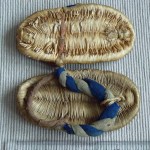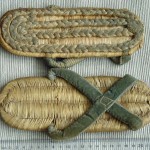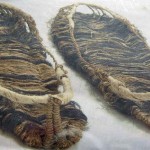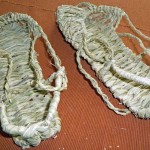Two recent acquisitions J9 and J10 came with an interesting story. Based on information from the seller, Kathryn Adams, my research and examination of the sandals, here are my conclusions about the path of these sandals:
William Barre and his wife Cora Adams Barre probably obtained the sandals during a trip to Japan in the early 1900s. They brought these Japanese sandals with them upon their return home to Manila, The Philippines. The sandals were passed to Cora’s younger sister Florence, known in the family as Floss. Sometime after the family returned to Ohio in late 1907, the shoes passed from Florence to her brother J.Q. Adams. His granddaughter Kathryn is the seller. It is unusual for antique straw sandals to be traceable for over 100 years.
The sandals arrived with several interesting side stories. William Barre was a young banker from Nebraska who became involved in the Spanish American War and ended up in Manila. Because of his financial experience and contacts, he became Assistant Comptroller and then Comptroller of The Philippines. Kathryn contributed an old photograph of Cora Adams Barre dressed in a Japanese kimono and performing a tea ceremony, evidence of a visit to Japan. Kathryn told me a great story about Floss and a young U.S. Army Lieutenant named Douglas MacArthur. The family summered in the town of Bagio in the mountains above Manila. As the summer heat subsided, the sisters rode horses side saddle during their return home to Manila. Floss met MacArthur at a dance at the Army-Navy Club. Several days later, Lieutenant MacArthur arrived at their home at lunchtime on horseback in a driving tropical rain. He presented his card to the house boys, Pedro and Amelio, but apparently they did not recognize him as a friend of the family, and he was not invited in. However, Douglas and Floss eventually began dating. In 1904, Lieutenant MacArthur was shipped back to the U.S. During the Pacific transit, he wrote letters and a diary to Floss. And yes, this is the same Douglas MacArthur who rose to the rank of General of the Army (U.S.) and who was awarded the U.S. Medal of Honor for his service in the Philippines Campaign. These materials are now housed in the William L. Clements Library at the University of Michigan, as part of the Douglas MacArthur collection. (Click on image to enlarge: Left, Cora Adams Barre; Middle, J9; Right, J10)





